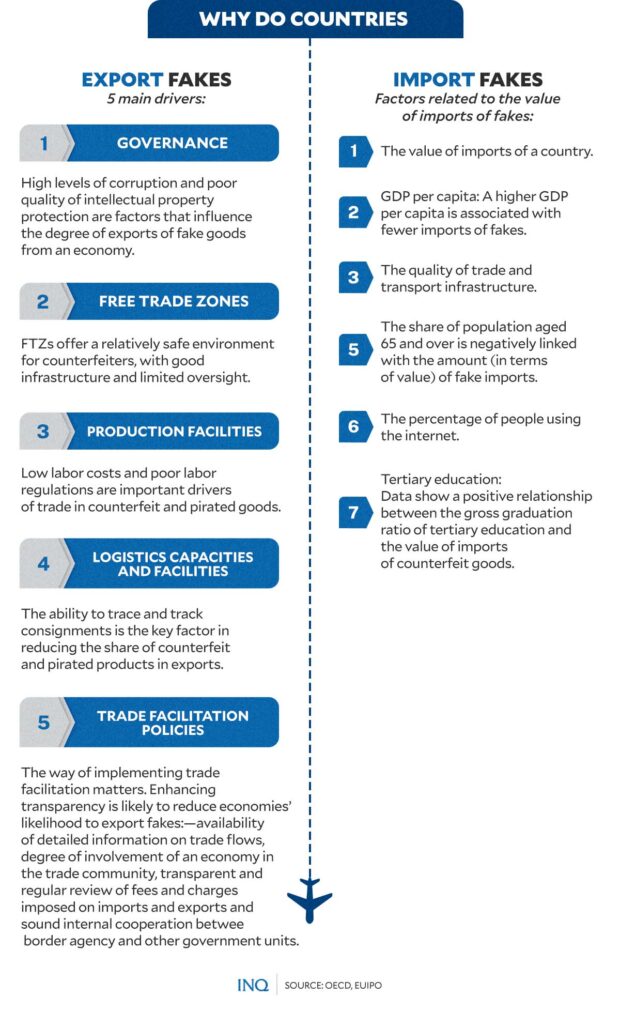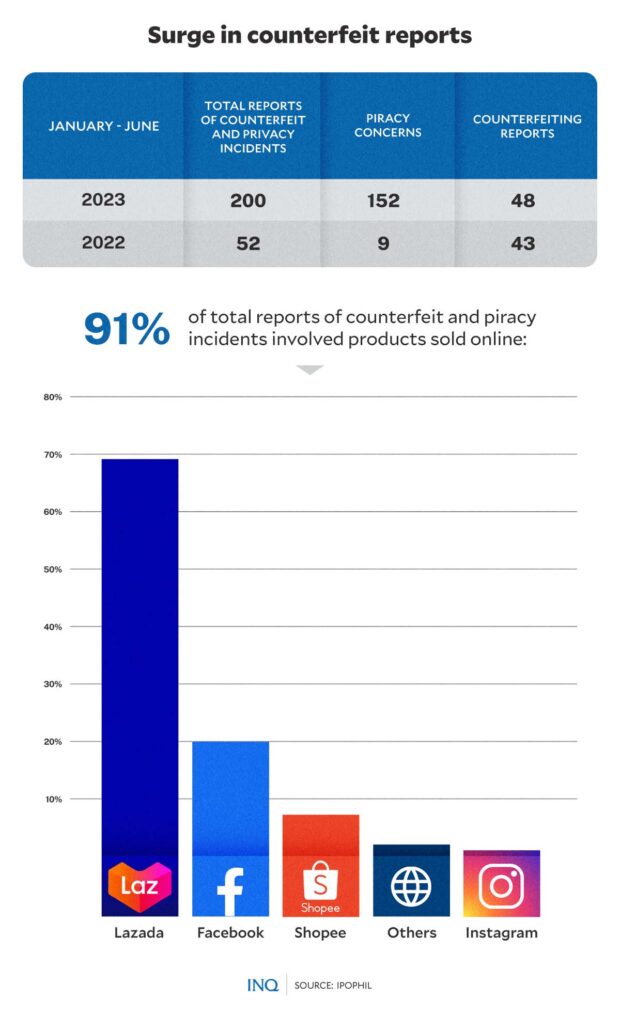Anti-Piracy Month: Lazada tops PH list of online source of fake goods

COMPOSITE IMAGE FROM INQUIRER FILE PHOTOS
MANILA, Philippines—The National Anti-Piracy Month is observed in the Philippines every October to raise public awareness on piracy or counterfeiting of various media and goods, which remains a huge problem in the country.
In 2003, then-President Gloria Macapgal-Arroyo signed Proclamation No. 448, declaring the month of October every year as “National Anti-Video Piracy Month,” citing the “rampant and indiscriminate piracy of videograms has greatly affected the movie industry.”
Five years later, in October 2018, then-President Rodrigo Duterte signed Proclamation No. 596, amending Proclamation No. 448 to declare the month of October every year as National Anti-Piracy Month.
“[T]here is a need to continuously elevate the awareness of the public regarding piracy or counterfeiting of optical, magnetic and such other emerging similar media, and its adverse effects on the economy,” the Duterte proclamation stated.
Piracy involves the “unauthorized use, reproduction, distribution, or downloading of copyrighted materials without the permission of the copyright holder,” explained the Intellectual Property Office of the Philippines (IPOPHL), a government agency mandated to administer and implement policies on intellectual property (IP) to strengthen the protection of IP rights in the country.
Surge in piracy, counterfeit reports
In the first half of 2023, IPOPHL reported that counterfeit and piracy reports spiked by 286 percent, driven by complaints concerning pirated gaming software and bootlegged apparel, perfume, and beauty products.
From January to June this year, the agency recorded 200 reports of counterfeit and piracy incidents, nearly four times the 52 reports it received in the same period last year.

GRAPHIC Ed Lustan
Piracy concerns totaled 152, accounting for around 76% of the total reports — a huge jump from just nine reports recorded in the same period last year.
“The spike in piracy reports is as interesting as what — or who — drove them,” Deputy Director General Ann Claire C. Cabochan said.
According to Cabochan, 135 or 89% of the total piracy reports were filed by a single individual, with 133 reports logged in January alone. IPOPHL noted that the individual mainly reported on pirated gaming software.
Meanwhile, the agency recorded 48 reports on counterfeiting, around 9 percent higher than the 43 reports received last year. The reports involved fake apparel, perfume and beauty products, and accessories.
The IP protection body said of all cases of piracy and counterfeiting, 91 percent were about infringement of materials online.
The online marketplace Lazada was on top of the list with 69 percent of cases. It was followed by Facebook, which also operates an online market, with 20 percent of the cases. Shopee, another online marketplace, had 7 percent of the cases.
Non-mainstream websites accounted for 2 percent of piracy and counterfeiting cases, while Instagram, also operated by the notorious Facebook, had 1 percent of the cases.
Pirated, counterfeit goods
While piracy is often associated with digital media — such as movies, music, software, and books — it can also extend to physical goods.
Based on the World Trade Organization (WTO) Agreement on Trade-Related Aspects of Intellectual Property Rights (TRIPS)—the most comprehensive multilateral agreement on intellectual property—pirated goods refer to:

GRAPHIC Ed Lustan
“Any goods which are copies made without the consent of the right holder or person duly authorized by the right holder in the country of production and which are made directly or indirectly from an article where the making of that copy would have constituted an infringement of a copyright or a related right under the law of the country of importation.”
Counterfeit trademark goods refer to:
“Any goods, including packaging, bearing without authorization a trademark which is identical to the trademark validly registered in respect of such goods, or which cannot be distinguished in its essential aspects from such a trademark, and which thereby infringes the rights of the owner of the trademark in question under the law of the country of importation.”
Trading counterfeit and pirated goods is considered illegal and is against international intellectual property laws. However, studies have shown that the illegal trade remains bustling over the past few years, despite measures imposed by countries across the globe.

GRAPHIC Ed Lustan
“Counterfeit trade takes away revenues from firms and governments and feeds other criminal activities,” said Marcos Bonturi, governance director of the Organization for Economic Cooperation and Development (OECD).
“It can also jeopardize consumers’ health and safety,” Bonturi said.
In 2019, the OECD and the European Union Intellectual Property Office (EUIPO) found that East Asia dominated the global trade in counterfeit and pirated goods—with China and Hong Kong being the most notorious.
Aside from China and Hong Kong, most counterfeit and pirated goods traded internationally also came from Turkey, Singapore, Malaysia, the United States, Taipei, Iran, Russia, the United Arab Emirates, Thailand, and Vietnam.
Among the top product categories being faked and pirated in 2019 were:
- Footwear (Examples are fake Nikes, Adidas and other brands that are widespread in Philippine outlets)
- Clothing (knitted or crocheted)
- Articles of leather, handbags
- Electrical machinery and electronics
- Perfumery and cosmetics
- Toys and games
- Watches
- Jewelry
- Optical, photographic medical apparatus
- Vehicles
- Clothing and accessories (not knitted or crocheted)
The top five industries commonly targeted by counterfeiters, based on 2019 data, were perfumery and cosmetics; articles of leather, handbags; clothing (knitted or crocheted); footwear; and watches.
PH’s mountain of fake goods
A separate report released last year by the Office of the United States Trade Representative identified a counterfeit hotspot as Greenhills Shopping Center in San Juan, Metro Manila, which the report said has many storefronts that sell counterfeit goods such as electronics, perfumes, watches, shoes, accessories, and fashion items.
“Although the Philippines government established an enforcement and monitoring agreement with the city of San Juan and created a working group composed of various agencies from the National Committee on Intellectual Property Rights and the Department of Information and Communications Technology, sellers of counterfeit goods are reportedly becoming bolder in displaying and openly discussing the illicit nature of the counterfeit goods, instead of discretely hiding the counterfeit goods under the tables as they did in the past,” the report stated.
In 2021, the value of counterfeit goods seized by the National Committee on Intellectual Property Rights (NCIPR) reached another record-high at P24.9 billion.
The figures were based on the estimated value of seized illicit items from operations and raids conducted by different agencies such as the National Bureau of Investigation (NBI), Philippine National Police (PNP), Optical Media Board (OMB), Bureau of Customs (BOC), Food and Drug Administration (FDA).
It also included figures from joint operations by the BOC, PNP-Criminal Investigation and Detection Group (CIDG), the Bureau of Internal Revenue (BIR), and the Philippine Drug Enforcement Agency (PDEA).
In July 2023, the BOC-Port of Subic apprehended two 40-foot container shipments containing P240M worth of counterfeit goods. The seized counterfeit goods were labeled as Balenciaga, Louis Vuitton, Adidas, Calvin Klein, Under Armour, Lacoste, GAP, Nike, Zara, Reebok, and other brands.
A month prior, BOC seized around 2.2 million pairs of counterfeit shoes — designs of which were copied from a popular global brand — worth P1.5B. In February, the agency also seized P1.5B worth of counterfeit items in Pasay City.
‘Stop piracy’
“Let’s all be reminded that piracy is a significant issue that can lead to financial losses of content creators, artists, and businesses and can also pose risks to consumers as pirated materials may contain malware and ransomware,” the IPOPHL said.
The agency reminded the public to stop patronizing pirated content and to stop illegal downloading and streaming.
“Such sheer will to combat piracy gives IPOPHL hope that we have individual allies out there who want to set things right,” Cabochan previously said.
“It also gives us hope to see the impact of what one person can do. Imagine what we in this room can do together,” she added.
RELATED STORIES
Intellectual property rights-related reports, complaints soared in 2020 — IPOPHL
Proposed ordinance against ‘illicit trade, fake goods’ up for public hearing
Disclaimer: The comments uploaded on this site do not necessarily represent or reflect the views of management and owner of Cebudailynews. We reserve the right to exclude comments that we deem to be inconsistent with our editorial standards.
